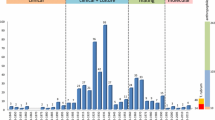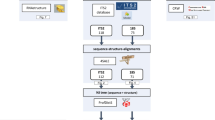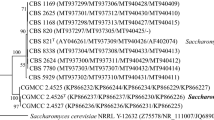Abstract
The nuclear small subunit rRNA genes of authentic strains of the black yeastsExophiala dermatitidis, Wangiella dermatitidis, Sarcinomyces phaeomuriformis, Capronia mansonii, Nadsoniella nigra var.hesuelica, Phaeoannellomyces elegans, Phaeococcomyces exophialae, Exophiala jeanselmei var.jeanselmei andE. castellanii were amplified by PCR and directly sequenced. A putative secondary structure of the nuclear small subunit rRNA ofExophiala dermatitidis was predicted from the sequence data. Alignment with corresponding sequences fromNeurospora crassa andAureobasidium pullulans was performed and a phylogenetic tree was constructed using the neighbor-joining method. The obtained topology of the tree was confirmed by bootstrap analysis. Based upon this analysis all fungi studied formed a well-supported monophyletic group clustering as a sister group to one group of the Plectomycetes (Trichocomaceae and Onygenales). The analysis confirmed the close relationship postulated betweenExophiala dermatitidis, Wangiella dermatitidis andSarcinomyces phaeomuriformis. This monophyletic clade also contains the teleomorph speciesCapronia mansonii thus confirming the concept of a teleomorph connection of the genusExophiala to a member of the Herpotrichiellaceae. However,Exophiala castellanii did not belong to this clade. Therefore, this species is not the anamorph ofCapronia mansonii as it was postulated.
Similar content being viewed by others
References
Bernier L, Hamelin RC & Ouellette GB (1994) Comparison of ribosomal DNA length and restriction site polymorphism inGremmeniella andAscocalyx isolates. Appl. Environ. Microbiol. 60: 1279–1286
Braams J (1993) Ecological studies on the fungal microflora inhabiting historical sandstone monuments. Ph. D. Thesis, Oldenburg
Butterfield W & Jong SC (1976) Effect of carbon source on conidiogenesis inFonsecaea dermatitidis, agent of chromomycosis. Mycopathologia 58: 59–62
Bruns TD, White TJ & Taylor JAW (1991) Fungal molecular systematics. Ann. Rev. Ecol. Syst. 22: 525–564
Castellani (1905) Tropical form of pityriasis versicolor. Br. Med. J. 2: 1271–1272
Cole GT (1978) Conidiogenesis in the black yeasts. PAHO Sci. Publ. 356: 66–78
Dixon DM & Polak-Wyss A (1990) The medically important dematiaceous fungi and their identification. Mycoses 34: 1–18
Felsenstein J (1985) Confidence limits on phylogenies: an approach using the bootstrap. Evolution 39: 783–791
Gast RJ, Fuerst PA & Byers TJ (1994) Discovery of group I introns in the nuclear small subunit ribosomal RNA genes ofAcanthamoeba. Nucl. Acids Res. 22: 592–596
Goodwin DC & Lee SB (1993) Microwave miniprep of total genomic DNA from fungi, plants, protists and animals for PCR. BioFeedback 15: 438–444
Gutell RR (1993) Collection of small subunit (16S- and 16S-like) ribosomal RNA structures. Nucl. Acids Res. 21: 3051–3054
Haase G, Skopnik H, Groten T, Kusenbach G & Posselt H-G (1991) Long-term fungal cultures from patients with cystic fibrosis. Mycoses 34: 373–376
Hendriks L, Goris A, Peer Y van de, Neefs JM, Vancanneyt M, Kersters K, Hennebert GL & Wachter R de (1991) Phylogenetic analysis of five medically importantCandida species as deduced on the basis of small subunit RNA sequences. J. General Microbiol. 137: 1223–1230
Hiruma M, Kawada A, Ohata T, Ohnishi &, Takahashi H, Yamazaki M, Ishibashi A, Hatsuse K, Kakihara M & Yoshida M (1993) Systemic phaeohyphomycosis caused byExophiala dermatitidis. Mycoses 36: 1–7
Hoog GS de (1977)Rhinocladiella and allied genera. Stud. Mycol. 15: 1–140
—— (1985) The taxonomic structure ofExophiala. In: Howard DH (Ed) Fungi Pathogenic for Humans and Animals, BII (pp 327–336) Marcel Dekker, New York
—— (1993) Evolution of black yeasts: possible adaptation to the human host. Antonie van Leeuwenhoek 63: 105–109
Hoog GS de & McGinnis MR (1987) Ascomycetous black yeasts. In: Hoog GS de, Smith MT & Weijman ACM (Eds) The Expanding Realm of Yeast-Like Fungi (pp 187–199) Elsevier, Amsterdam
Hoog GS de & Haase G (1993) Nutritional physiology and selective isolation ofExophiala dermatitidis. Antonie van Leeuwenhoek 64: 17–26
Hoog GS de, Sigler L, Untereiner WA, Kwon-Chung KJ, Guého E & Uijthof JMJ (1994a) Changing taxonomic concepts and their impact on nomenclature stability. J. Med. Vet. Mycol. 32 Suppl. 1: 113–122
Hoog GS de, Takeo K, Yoshida S, Göttlich E, Nishimura K & Miyaji M (1994b) Pleoanamorphic life cycle ofExophiala (Wangiella) dermatitidis. Antonie van Leeuwenhoek 65: 143–153
Iwatsu T, Nishimura K & Miyaji M (1984)Exophiala castellanii sp. nov. Myoctaxon 20: 307–314
Iwatsu T & Udagawa SI (1990)Exophiala jeanselmei var.castellanii, a new combination forExophiala castellanii. Mycotaxon 37: 291–292
Jukes TH & Cantor CR (1969) Evolution of protein molecules. In: Munro HN (Ed) Mammalian Protein Metabolism (pp 21–132) Academic Press, New York
Kurtzman CP (1992) rRNA sequence comparisons for assessing phylogenetic relationships among yeasts. Int. J. Syst. Bacteriol. 42: 1–6
Kusenbach G, Skopnik H, Haase G, Friedrichs F & Doehmen H (1992)Exophiala dermatitidis pneumonia in cystic fibrosis. Eur. J. Pediatr. 151: 344–346
Kwong-Chung KJ & Bennet JE (1992) Medical mycology, Lea & Febiger, Philadelphia
Matsumoto T, Padhye AA, Ajello L, Standard P & McGinnis MR (1984) Critical review of human isolates ofWangiella dermatitidis. Mycologia 76: 232–239
Matsumoto T, Padhye AA, Ajello L & McGinnis MR (1986)Sarcinomyces phaeomuriformis: a new dematiaceous hyphomycete. J. Med. Vet. Mycol. 24: 395–400
Matsumoto T, Matsuda T & McGinnis MR (1990) A previously undescribed synanamorph ofWangiella dermatitidis. J. Med. Vet. Mycol. 28: 437–444
Matsumoto T, Matsuda T, McGinnis MR & Ajello L (1993) Clinical and mycological spectra ofWangiella dermatitidis infections. Mycoses 36: 145–155
McCarrol R, Olsen GJ, Stahl YD, Woese CR & Sogin ML (1983) Nucleotide sequence of theDictyostelium discoideum small-subunit ribosomal ribonucleic acid inferred from gene sequence: evolutionary implications. Biochemistry 22: 5858–5868
McGinnis MR (1977)Wangiella, a new genus to accommodateHormiscium dermatitidis. Mycotaxon 5: 353–363
McGinnis MR, Schell WA & Carson J (1985)Phaeoannellomyces and the Phaeococcomycetaceae, new dematiaceous blastomycete taxa. Sabouraudia 23: 179–188
McGinnis MR, Sigler L, Bowman BH, Masuda M & Wang CJK (1992) Impact of conidiogenesis, teleomorph connections, pleomorphism and molecular genetics on evolving hyphomycete systematics. J. Med. Vet. Mycol. 30: 261–269
Müller E, Petrini O, Fisher PJ, Samuels GJ & Rossman AY (1987) Taxonomy and anamorphs of the Herpotrichiellaceae with notes on generic synonymy. Trans. Br. Mycol. Soc. 88: 63–74
Neefs J-M, Peer Y van de, Rijk P de, Chapelle S & Wachter R de (1993) Compilation of small ribosomal subunit RNA structures. Nucl. Acids Res. 21: 3025–3049
Peer Y van de & Wachter R de (1993) TREECON: a software package for the construction and drawing of evolutionary trees. Comput. Applic. Biosci. 9: 177–182
—— (1994) TREECON for Windows: a software package for the construction and drawing of evolutionary trees for the Microsoft Windows environment. Comput. Applic. Biosci. 10: 569–570
Priest PP de (1993) Small subunit rDNA variation in a population of lichen fungi due to optional group-I introns. Gene 134: 67–74
Rijk P de & Wachter R de (1993) DCSE, an interactive tool for sequence alignment and secondary structure research. Comput. Applic. Biosci. 9: 735–740
Saitou N & Nei M (1987) The neighbor-joining method: a new method for reconstructing phylogenetic trees. Mol. Biol. Evol. 4: 406–425
Samuels GJ & Müller E (1978) Life-history studies of Brazilian ascomycetes. Sydowia 31: 142–156
Schol-Schwarz MB (1968)Rhinocladiella, its synonymFonsecaea and its relation toPhialophora. Antonie van Leeuwenhoek 34: 119–152
Schwinn A, Strohm S, Helgenberger M, Rank C & Bröcker E-B (1993) Phaeohyphomycosis caused byExophiala jeanselmei treated with itraconazole. Mycoses 36: 445–448
Shen R & Lachance MA (1993) Phylogenetic study of ribosomal DNA of cactophilicPichia species by restriction mapping. Yeast 9: 315–330
Spatafora JW & Blackwell M (1993) Molecular systematics of unitunicate perithecial ascomycetes: The Clavicipitales-Hypocreales connection. Mycologia 85: 912–922
Wachter R de, Neefs JM, Goris A & Peer Y van de (1992) The gene coding for small subunit RNA in the basidiomyceteUstilago maydis contains a group I intron. Nucl. Acids Res. 20: 1251–1257
White TJ, Bruns TD, Lee SB & Taylor JAW (1990) Amplification and direct sequencing of fungal ribosomal RNA genes for phylogenetics. In: Innis N, Gelfand J & White T (Eds) PCR Protocols: A Guide to Methods and Applications (pp 315–322) Academic Press, New York
Willmotte A, Peer Y van de, Goris A, Chapelle S, Baere R de, Nelissen B, Neefs JM, Hennebert GL & Wachter R de (1993) Evolutionary relationship among higher fungi inferred from small ribosomal subunit RNA sequence analysis. System. Appl. Microbiol. 16: 436–444
Winnepenninckx B, Peer Y van de, Backeljau T & Wachter R de (1995) CARD: a drawing tool for RNA secondary structure models. Biotechniques (in press)
Wollenzien U, Hoog GS de, Krumbein WE & Urzì C (1994) On the isolation, cultivation and taxonomy of microcolonial fungi occurring on and in marble and other calcareous rocks. Sci. Total. Environm. (in press)
Author information
Authors and Affiliations
Rights and permissions
About this article
Cite this article
Haase, G., Sonntag, L., van de Peer, Y. et al. Phylogenetic analysis of ten black yeast species using nuclear small subunit rRNA gene sequences. Antonie van Leeuwenhoek 68, 19–33 (1995). https://doi.org/10.1007/BF00873289
Issue Date:
DOI: https://doi.org/10.1007/BF00873289




